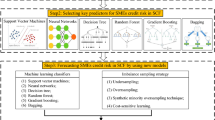Abstract
Supply chain finance (SCF) becomes more important for small- and medium-sized enterprises (SMEs) due to global credit crunch, supply chain financing woes and tightening credit criteria for corporate lending. Currently, predicting SME credit risk is significant for guaranteeing SCF in smooth operation. In this paper, we apply six methods, i.e., one individual machine learning (IML, i.e., decision tree) method, three ensemble machine learning methods [EML, i.e., bagging, boosting, and random subspace (RS)], and two integrated ensemble machine learning methods (IEML, i.e., RS–boosting and multi-boosting), to predict SMEs credit risk in SCF and compare the effectiveness and feasibility of six methods. In the experiment, we choose the quarterly financial and non-financial data of 48 listed SMEs from Small and Medium Enterprise Board of Shenzhen Stock Exchange, six listed core enterprises (CEs) from Shanghai Stock Exchange and three listed CEs from Shenzhen Stock Exchange during the period of 2012–2013 as the empirical samples. Experimental results reveal that the IEML methods acquire better performance than IML and EML method. In particular, RS–boosting is the best method to predict SMEs credit risk among six methods.








Similar content being viewed by others
References
More D, Basu P (2013) Challenges of supply chain finance: a detailed study and a hierarchical model based on the experiences of an Indian firm. Bus Process Manag J 19(4):624–647
Fairchild A (2005) Intelligent matching: integrating efficiencies in the financial supply chain. Supply Chain Manag Int J 10(4):244–248
Knox A (2005) Electronic payment: the missing link in supply chain efficiency. J Financ Transform Mark Imperfection 14:16–18
Hofmann E, Belin O (eds) (2011) Supply chain finance solutions. Springer, Berlin
Seifert RW, Seifert D (2011) Financing the chain. Int Commer Rev 10(1):32–44
Sopranzetti BJ (1999) Selling accounts receivable and the underinvestment problem. Q Rev Econ Finance 39(2):291–301
Wuttke DA, Blome C, Henke M (2013) Focusing the financial flow of supply chains: an empirical investigation of financial supply chain management. Int J Prod Econ 145(2):773–789
Wang G, Ma J (2011) Study of corporate credit risk prediction based on integrating boosting and random subspace. Expert Syst Appl 38(11):13871–13878
Huang Z, Chen H, Hsu CJ, Chen WH, Wu S (2004) Credit rating analysis with support vector machines and neural networks: a market comparative study. Decis Support Syst 37(4):543–558
Brill J (1998) The importance of credit scoring models in improving cash flow and collections. Bus Credit 100(1):16–17
Thomas LC (2000) A survey of credit and behavioral scoring: forecasting financial risks of lending to customers. Int J Forecast 16(2):149–172
Jiang Y (2009) Credit scoring model based on the decision tree and the simulated annealing algorithm. In: 2009 World congress on computer science and information engineering. Los Angeles, CA, pp 18–22
West D (2000) Neural network credit scoring models. Comput Oper Res 27(11):1131–1152
Nanni L, Lumini A (2009) An experimental comparison of ensemble of classifiers for bankruptcy prediction and credit scoring. Expert Syst Appl 36(2):3028–3033
Tsai C, Wu J (2008) Using neural network ensembles for bankruptcy prediction and credit scoring. Expert Syst Appl 34(4):2639–2649
Webb GI (2000) Multiboosting: a technique for combining boosting and wagging. Mach Learn 40(2):159–196
Zhou Z (ed) (2009) Ensemble. In: Encyclopedia of database systems. Springer, New York
Hall MA, Smith LA (1998) Practical feature subset selection for machine learning. In: Computer science ’98 proceedings of the 21st Australasian computer science conference ACSC ’98, Berlin, pp 181–191
Quinlan JR (ed) (1993) C4.5: programs for machine learning. Morgan Kaufmann Publishers, San Francisco, CA
Maclin R, Opitz D (1999) Popular ensemble methods: an empirical study. J Artif Intell Res 11:169–198
Fu ZW, Golden BL, Lele S, Raghavan S, Wasil E (2006) Diversification for better classification trees. Comput Oper Res 33(11):3185–3202
Breiman L (1996) Bagging predictors. Mach Learn 24(2):123–140
Bauer E, Kohavi R (1999) An empirical comparison of voting classification algorithms: bagging, boosting, and variants. Mach Learn 36(1–2):105–139
Freund Y, Schapire RE (1996) Experiments with a new boosting algorithm. In: Thirteenth international conference on machine learning, San Francisco, pp 148–156
Ho TK (1998) The random subspace method for constructing decision forests. IEEE Trans Pattern Anal Mach Intell 20(8):832–844
Xiong X, Ma J, Zhao W (2009) Credit risk analysis of supply chain finance. Nankai Bus Rev 12(4):92–98
Powers DMW (2011) Evaluation: from precision, recall and F-measure to ROC, informedness, markedness & correlation. J Mach Learn Technol 2(1):37–63
Hosmer JDW, Lemeshow S, Sturdivant RX (eds) (2013) Applied logistic regression. Wiley, Hoboken, NJ
Yap BW, Ong SH, Husain NHM (2011) Using data mining to improve assessment of credit worthiness via credit scoring models. Expert Syst Appl 38(10):13274–13283
Kürüm E, Yildirak K, Weber GW (2012) A classification problem of credit risk rating investigated and solved by optimization of ROC curve. Cent Eur J Oper Res 20(3):529–557
Bekhet HA, Eletter SFK (2014) Credit risk assessment model for Jordanian commercial banks: neural scoring approach. Rev Dev Finance 4(1):20–28
Alexander F, Daniel M (2007) Measuring word alignment quality for statistical machine translation. Comput Linguist 33(3):293–303
Acknowledgments
This work was supported by the National Natural Science Foundation of China under Grant Nos. 71373072 and 71501066; the China Scholarship Council under Grant No. 201506135022; Specialized Research Fund for the Doctoral Program of Higher Education under Grant No. 20130161110031; and Foundation for Innovative Research Groups of the National Natural Science Foundation of China under Grant No. 71221001.
Author information
Authors and Affiliations
Corresponding author
Rights and permissions
About this article
Cite this article
Zhu, Y., Xie, C., Wang, GJ. et al. Comparison of individual, ensemble and integrated ensemble machine learning methods to predict China’s SME credit risk in supply chain finance. Neural Comput & Applic 28 (Suppl 1), 41–50 (2017). https://doi.org/10.1007/s00521-016-2304-x
Received:
Accepted:
Published:
Issue Date:
DOI: https://doi.org/10.1007/s00521-016-2304-x




